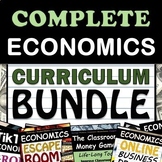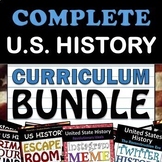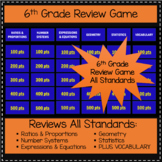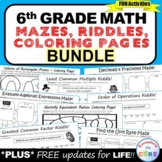54 results
6th grade government independent work packets for Microsoft Word
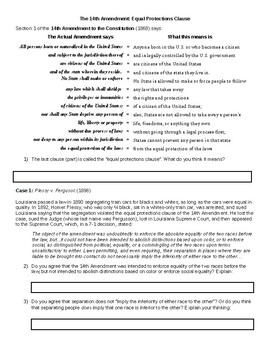
14th Amendment and the Equal Protections Clause
This handout has students learn about the 14th Amendment's equal protections clause and then read about and analyze several seminal Supreme Court decisions about the clause including Plessy v. Ferguson and Brown v. Board of Education. They also analyze the stop and frisk policy of the NYPD, the 1964 Civil Rights Act and protected classes, and subsequent Supreme Court cases that relate to it (Lawrence v. Texas, Obergefell v. Hodges, and Bostock v. Clayton County). It ends with asking students to
Subjects:
Grades:
6th - 12th, Higher Education, Adult Education
Also included in: Law and Justice Curriculum
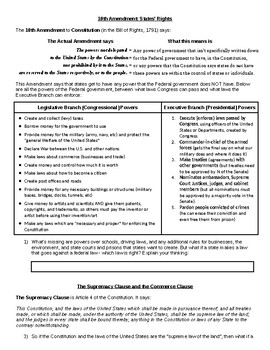
Supremacy & Commerce Clauses, & 10th Amendment (Distance Learning and COVID-19)
This handout helps students understand the 10th Amendment to the Constitution, the Supremacy Clause, the Commerce Clause, and seminal Supreme Court cases related to these. It includes a final question about COVID-19 in relation to Federal and state powers. It is formatted for Google Classroom.
Subjects:
Grades:
6th - 12th, Higher Education, Adult Education
Also included in: Law and Justice Curriculum

Constitutional Convention and Compromises Debate Activity (Distance Learning)
This independent work packet has students analyze 4 conflicts at the Constitutional Convention (state vs. federal power, how to represent the states, slavery vs. free states, and Federalists vs. Anti-Federalists) and 3 compromises that somewhat resolved them. It is formatted for google classroom. I have gotten some very rich debates from students using this handout.
Subjects:
Grades:
6th - 12th, Higher Education, Adult Education
Also included in: Law and Justice Curriculum
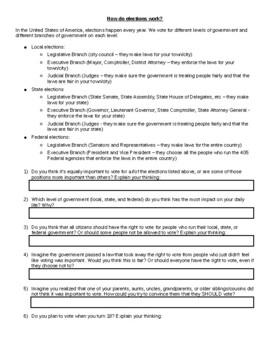
Elections, Voting, Voter Turnout, and Demographics of Voters
This is a packet for students that has them learn about the different elections (local, state, and federal) and different positions within them, then brainstorm many questions about voting and why it is important, which elections are more important to vote for, and how the government should increase or decrease voter turnout. Then, students learn about the differences between a primary and general election. Finally, the bulk of the packet explores voter turnout in midterm vs. presidential electi
Subjects:
Grades:
5th - 12th, Higher Education, Adult Education
Also included in: Participation in Government Curriculum
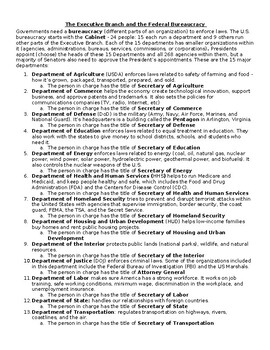
The Executive Branch and the Federal Bureaucracy
This handout explains the 15 Cabinet Departments and several of the 268 Federal bureaucracy agencies and what they do (along with their annual budget). The goal is for students to analyze how each agency affects their daily life. This can be the basis for further research, class discussions, or to give an overview of the Federal bureaucracy.
Subjects:
Grades:
6th - 12th, Higher Education, Adult Education
Also included in: Law and Justice Curriculum
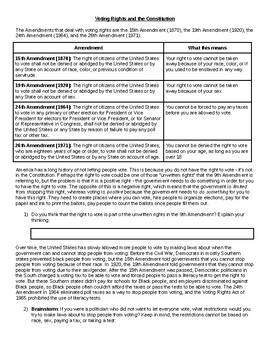
Voting Rights Amendments and Supreme Court Cases (Distance Learning)
This handout has students analyze the 4 voting rights Amendments (15th, 19th, 24th, and 26th), the Voting Rights Act, and 4 Supreme Court cases about voting (Baker v. Carr, Shelby County v. Holder, Thornburg v. Gingles, and Citizens United v. FEC. It is formatted for google classroom.
Subjects:
Grades:
6th - 12th, Higher Education, Adult Education
Also included in: Law and Justice Curriculum
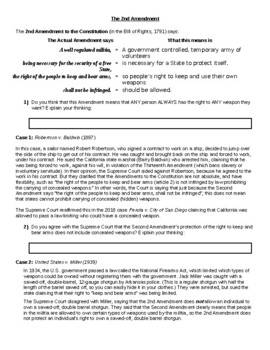
Second Amendment Rights
This handout has students explore and analyze six seminal Supreme Court cases about the Second Amendment and the right to bear arms, including stand your ground laws and the Castle Doctrine. It is formatted for google classroom, but it is a word document that can be reformatted with lines instead of boxes if you want to use it as an in class handout.
Subjects:
Grades:
6th - 12th, Higher Education, Adult Education
Also included in: Law and Justice Curriculum

Congress: The Legislative Branch and How it Works
This handout explains how Congress works (Senate and House of Representatives), including how a bill becomes a law, lobbying, and the powers of Congress. Students are asked analysis questions throughout that can be used for very rich class discussions.
Subjects:
Grades:
6th - 12th, Higher Education, Adult Education
Also included in: Law and Justice Curriculum
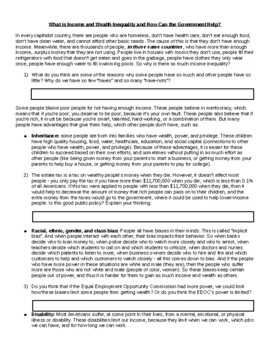
Income/Wealth Inequality and Government Help
This handout first has students learn about the causes of wealth and income inequality in the U.S. and then examine several methods that governments can use to alleviate and solve this inequality. The solutions range from supply-side to demand-side solutions, with an explanation of supply-side economics, demand-side economics, and laissez-faire capitalism. It is formatted for google classroom. This handout has given my students fodder for some of the richest debates in economics class, and can l
Subjects:
Grades:
6th - 12th, Higher Education, Adult Education
Also included in: Economics Bundle: Personal Finance, Businesses, and the Stock Market
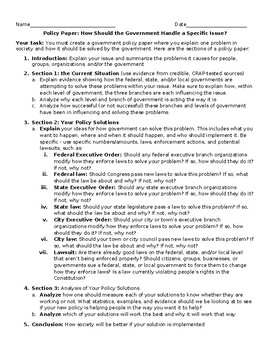
Government Policy Project
This assignment has students attempt to create a government policy to solve a specific problem or issue they see in society. They need to research credible sources (a CRAP test to see if a source is credible is included) and use their research to explain the problem, what laws or policies exist that are currently working or not working, what additional policies, laws, or lawsuits need to occur to fully solve the problem, and which branches and levels of government need to be utilized to solve it
Subjects:
Grades:
6th - 12th, Higher Education, Adult Education
Also included in: Law and Justice Curriculum

United States: Unity and Sectionalism
Mainly focused on the Missouri Compromise. Includes: article, guided reading activity, primary source activity, quiz, and answer keys.
Grades:
6th - 8th
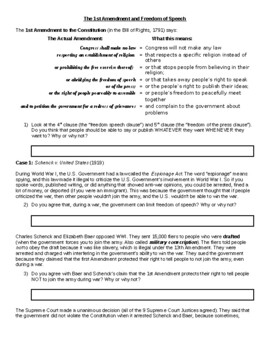
First Amendment and Freedom of Speech
This handout has students analyze several seminal Supreme Court cases related to the free speech clause in the First Amendment. It is formatted for google classroom, but is a word document so it can be reformatted with lines instead of boxes if you plan on using it in class, on paper.
Subjects:
Grades:
6th - 12th, Higher Education, Adult Education
Also included in: Law and Justice Curriculum

The Social Contract, Locke and Hobbes (Distance Learning)
This handout takes students through the ideas of the social contract, and how Thomas Hobbes and John Locke viewed human behavior in the state of nature, and thus how they viewed government. Students are frequently asked to apply these lenses to our current society, gradually understanding the rationale for why we have laws. Students really love to debate and discuss these ideas, so this is a great basis for lots of rich discussions in class. It is formatted for google classroom.
Subjects:
Grades:
6th - 12th, Higher Education, Adult Education
Also included in: Colonial America

Universal Declaration of Human Rights Activity and Research (Distance Learning)
This is a multi-day activity where students are each assigned a different article from the Universal Declaration of Human Rights (there are 30, so it works for 30 students, but there are also many articles with several sub-points, so it can work with even more than 30). Each student must paraphrase their assigned article into their own words, explain what it means to the class, and the class can then ask them clarifying questions. Then all students analyze how the United Nations should handle it
Subjects:
Grades:
6th - 12th, Higher Education, Adult Education
Also included in: Law and Justice Curriculum
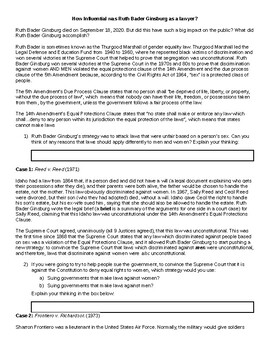
Ruth Bader Ginsburg and Levels of Scrutiny Handout (Distance Learning)
This handout focuses on the seminal equal rights cases that Ruth Bader Ginsburg contributed to or argued before the Supreme Court, such as Reed v. Reed, Frontiero v. Richardson, and Craig v. Boren. It also explores the levels of scrutiny applied to the government when limiting rights, since Ginsburg was instrumental in the creation of intermediate scrutiny. It is formatted for google classroom.
Subjects:
Grades:
6th - 12th, Higher Education, Adult Education
Also included in: Women's History Month Resources
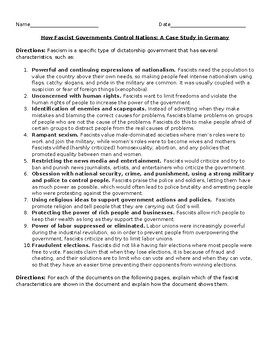
Fascism and the Nazis
This handout gives students a list of ten characteristics of fascism and then has them read several documents about the Nazis and try to identify and analyze which fascist characteristics they see in each document.
Subjects:
Grades:
6th - 12th, Higher Education, Adult Education
Also included in: European History (Ancient Greece to the Fall of the USSR)
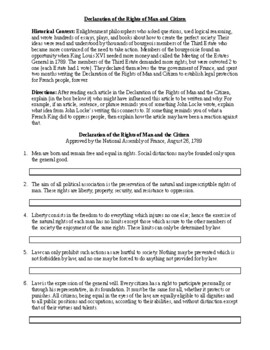
Declaration of the Rights of Man and the Citizen Worksheet (Distance Learning)
This handout can be used as a collaborative group activity or an assessment for an Age of Absolutism or Enlightenment unit. It gives students selected articles from the Declaration of the Rights of Man and the Citizen and asks them to connect each one to an Enlightenment philosopher OR an abusive act by the French monarchs. They need to be specific, so it will help if students have studied enlightenment philosophers in detail (https://www.teacherspayteachers.com/Product/Enlightenment-Philosopher
Subjects:
Grades:
6th - 12th, Higher Education, Adult Education
Also included in: Law and Justice Curriculum

Montesquieu, the Founding Fathers, and Separation of Powers
This handout has students analyze the historical connections between Baron de Montesquieu's political philosophy of separation of powers and the resulting division of power between state and federal governments AND among the three branches of government in the Constitution.
Subjects:
Grades:
6th - 12th, Higher Education, Adult Education
Also included in: U.S. Government and Constitution Bundle
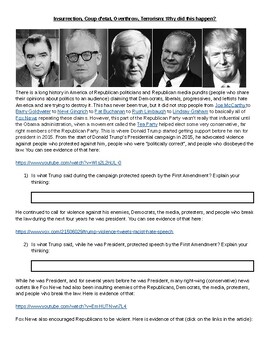
January 6 Insurrection Assignment
This assignment has students analyze the historical causes of the January 6, 2021 insurrection at the Capitol building in Washington D.C., including media sources, political figures, and which speech is protected by the First Amendment. This First Amendment and freedom os speech assignment might be a good complement to use as well:https://www.teacherspayteachers.com/Product/First-Amendment-and-Freedom-of-Speech-8385031
Subjects:
Grades:
6th - 12th, Higher Education, Adult Education
Also included in: Donald Trump Bundle
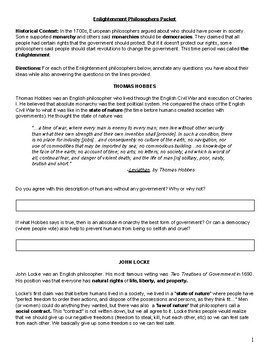
Enlightenment Philosophers Packet (Distance Learning)
This packet has students analyze the ideas and writings of Thomas Hobbes, John Locke, Jean Jacques Rousseau, Mary Wollstonecraft, and Voltaire through higher-order thinking questions. It is formatted for google classroom. I have gotten several days worth of discussion and debate out of this handout, so it can be used for more than just one day of lessons.
Subjects:
Grades:
6th - 12th, Higher Education, Adult Education
Also included in: Colonial America
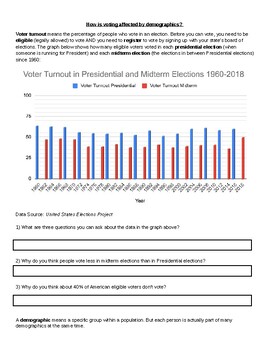
Voter Turnout Assignment (COVID-19 and Distance Learning)
This handout has students understand and analyze voter turnout, turnout in midterm vs. presidential elections, and turnout by various demographics (sex, age, income, education, an race/ethnicity). It then asks students to contemplate how the COVID-19 pandemic will impact turnout in the 2020 election. It is formatted for google classroom. Not only has this handout inspired very deep class discussions, but it also is a jumping off point for students to debate if we need mandatory voting or not. Th
Subjects:
Grades:
6th - 12th, Higher Education, Adult Education
Also included in: Current Political Issues in the United States
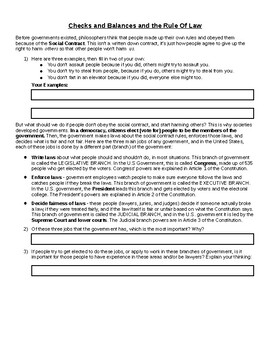
Basics of U.S. Government (Distance Learning)
This handout starts with asking students to analyze the social contract, then the basic functions of government and how they are broken into 3 branches (in the U.S.), then checks and balances and exploring what can be done if Presidents ignore the rule of law, and finally federalism and students explaining why it is or is not important to vote for different positions in local, state, and the federal government. It is formatted for Google Classroom. I have used this as the basis for 2-5 days of l
Subjects:
Grades:
6th - 12th, Higher Education, Adult Education
Also included in: Law and Justice Curriculum

Landlords, tenants, homeowners, government (COVID-19 and Distance Learning)
This independent work project has students learn about the crisis in housing costs during the COVID-19 pandemic from many perspectives (landlords, tenants, homeowners with mortgages) and the reasons why many people have lost income as well. Students are asked analysis questions and then tasked with both brainstorming ways government could solve these problems AND evaluating why their solutions might work and might not work. It is formatted for google classroom.
Subjects:
Grades:
6th - 12th, Higher Education, Adult Education
Also included in: Economics Bundle: Personal Finance, Businesses, and the Stock Market
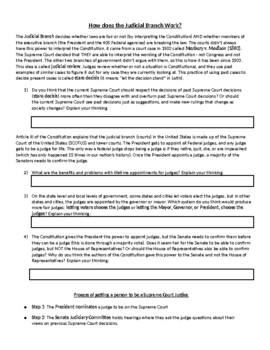
Judicial Branch, Supreme Court, Court Packing (Distance Learning)
This 4 page handout explains how the Judicial Branch works, including the Supreme Court and how to get a person nominated and confirmed, having students understand how cases move through the lower courts to get to the Supreme Court, and asks students to analyze some of the rules and conditions of the court, including whether the court should be expanded or not. It is formatted for google classroom, so it works for remote learning, and this has gotten a good day or two of debate from my students,
Subjects:
Grades:
6th - 12th, Higher Education, Adult Education
Also included in: Law and Justice Curriculum
Showing 1-24 of 54 results

